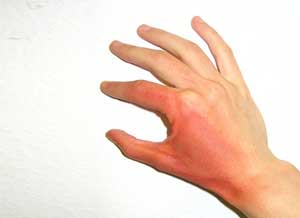- Home
- Editorial
- News
- Practice Guidelines
- Anesthesiology Guidelines
- Cancer Guidelines
- Cardiac Sciences Guidelines
- Critical Care Guidelines
- Dentistry Guidelines
- Dermatology Guidelines
- Diabetes and Endo Guidelines
- Diagnostics Guidelines
- ENT Guidelines
- Featured Practice Guidelines
- Gastroenterology Guidelines
- Geriatrics Guidelines
- Medicine Guidelines
- Nephrology Guidelines
- Neurosciences Guidelines
- Obs and Gynae Guidelines
- Ophthalmology Guidelines
- Orthopaedics Guidelines
- Paediatrics Guidelines
- Psychiatry Guidelines
- Pulmonology Guidelines
- Radiology Guidelines
- Surgery Guidelines
- Urology Guidelines
Guideline for Surgical and Nonsurgical wound management in Burns

The main aspects of burn care is burn wound and therefore its size, depth, and condition directly impacts fluid resuscitation, hypermetabolic response, immune system dysfunction, and predicted survival. Optimal care of the burn wound requires specialized facilities and experienced burn nurses and surgeons, all of which are in limited supply under normal circumstances.
Leopoldo C. Cancio Kearns RD and associates have formulated Guideline for Burn Care Under Austere Conditions, Surgical and Nonsurgical Wound Management, the goal of which is to provide a background for disaster preparedness and a framework for initial assessment in a burn mass casualty.The guidelines have been published in Journal of Burn Care & Research.
PAIN MANAGEMENT
Recommendations
- Continue to coordinate with hospital, community, state, and federal disaster planning agencies
- Know where all available supplies are located and how to secure and access them
- Take an active role in recommending analgesic medications effective in burn injury for inclusion in the SNS
- Develop a strategy that optimizes analgesic medication administration consistently to provide the most good for the greatest number of patients
- Be prepared to use any medication available for pain treatment and be prepared to think outside the box to use other resources that may mitigate pain after burn injury.
NUTRITION
Recommendations
- Consult the facility Emergency Operations Plan and emergency care planners to identify the food and nutritional supplement resources to be used in a BMCI
- Provide meals per hospital Emergency Care Plans to those able to eat
- Consider feeding tube (gastric or small bowel) if able and start enteral feeds if resources allow using whatever food is available
- Patients with <10% burns can generally be managed with increased caloric consumption in their regular diet; patients with >20% TBSA burn, mechanical ventilation, or severe face burns are likely to require supplementation
- Initial target intake: 50 to 60% of estimated calorie and protein needs
REHABILITATION
Recommendations
- Elevate limbs if they have significant swelling
- Position shoulders away from the body with elbows straight
- Position hands to avoid fisting
- Position legs away from the body with knees straight
- Position ankles at a right angle
- Stretch skin at least twice per day
- Train family to assist in therapy, if able
- Encourage sitting and walking as soon as possible
PEDIATRIC CONSIDERATIONS
Recommendations
- Keep children with a parent or designate a responsible adult to watch them
- Assign temporary names and guardians to unidentified preverbal children and preserve information on how and where they were found
- Keep the child warm using cosleep with the parent/guardian, extra blanket, avoid unnecessary baths
- Triage using objective tools such as JumpSTART13 if a multicasualty situation
- Calculate BSA burned using Lund–Browder chart or palm size
- Use oral rehydration and oral/enteral feedings if possible
- For pain management, cover the wounds with dressings and ointments, avoid unnecessary dressing changes, elevate the burned area, alternate splinting and active range of motion, and use distraction techniques around procedures. Ketamine is a useful procedural sedative if available.
- Operative interventions are high risk in austere circumstances. Use open amputation for gangrene, and limit blood loss using tourniquets and epinephrine clysis
- Recognize sepsis: hypothermia and hypoglycemia could be sepsis; beware of resuscitating patients with old wounds without preparation for ensuing septic shock
- Transfer the patient to a burn center when possible
PALLIATIVE CARE
- Be fair, evidence-based, and responsive to the needs of the patients
- Include processes and procedures for ensuring that decisions and implementation of the standards are made equitably
- Engage both the community and providers in the development of the standards, and provide adequate public education
- Become the rule of law when enacted
While numerous burn mass casualty planning articles have been published, none has directly addressed the issue of palliative care. The purpose of this article is to provide a framework for palliative care in a BMCI.
Recommendations
- All burn centers should work with the community to develop fair evidence-based palliative care guidelines to be used during a mass burn casualty.
- Patients triaged into the expectant category are those that will most benefit from palliative care.
- Community disaster plans should identify alternative sites of care (eg, hospices, long-term care facilities) for patients requiring palliative care.
- Pain and anxiety management with the best available pharmaceuticals is a priority.
- Artificial airways, supplemental oxygen, and bronchodilators if available may be beneficial for the prevention/management of air hunger.
- Privacy and access to family and spiritual supports should be provided.
For further reference log on to: https://doi.org/10.1097/BCR.0000000000000369

Disclaimer: This site is primarily intended for healthcare professionals. Any content/information on this website does not replace the advice of medical and/or health professionals and should not be construed as medical/diagnostic advice/endorsement or prescription. Use of this site is subject to our terms of use, privacy policy, advertisement policy. © 2020 Minerva Medical Treatment Pvt Ltd